BUS501 Business Analytics and Statistics: Honeybee Fruit Report
VerifiedAdded on 2023/06/04
|16
|3113
|326
Report
AI Summary
This report presents a comprehensive analysis of Honeybee Fruit's sales performance, aiming to provide actionable insights for the CEO to maximize revenue and profits. The study identifies the best and worst-selling products, revealing that water, fruit, and vegetables are the top performers, while juicing, herbal teas, and spices lag behind. A t-test indicates that credit card payments generate significantly higher revenue compared to cash payments. Furthermore, ANOVA tests demonstrate that product location within the store significantly impacts sales, while monthly gross profits vary, but net sales do not. Seasonal variations do not significantly affect gross sales. The report recommends optimizing product placement strategies and streamlining payment methods to enhance sales and profitability.
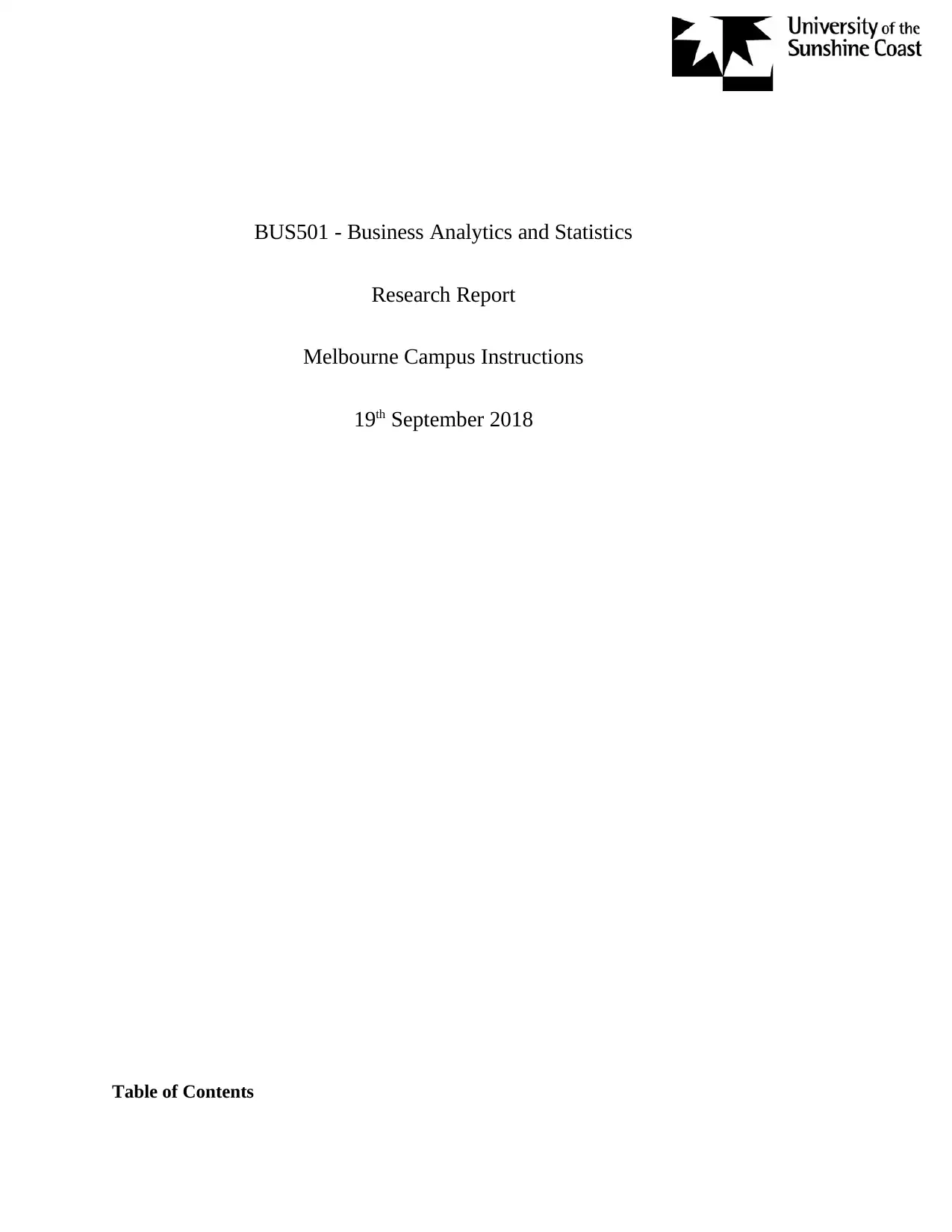
BUS501 - Business Analytics and Statistics
Research Report
Melbourne Campus Instructions
19th September 2018
Table of Contents
Research Report
Melbourne Campus Instructions
19th September 2018
Table of Contents
Paraphrase This Document
Need a fresh take? Get an instant paraphrase of this document with our AI Paraphraser
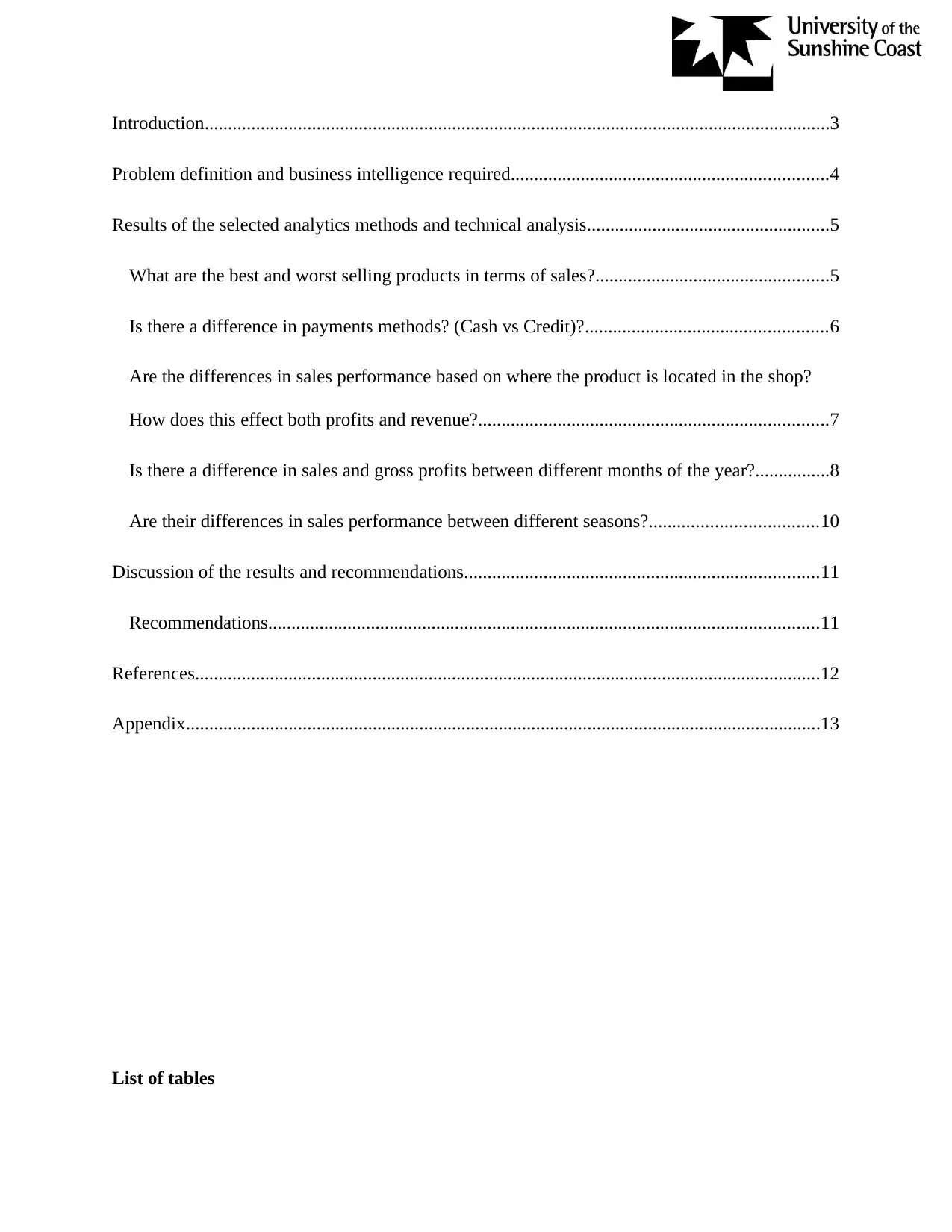
Introduction......................................................................................................................................3
Problem definition and business intelligence required....................................................................4
Results of the selected analytics methods and technical analysis....................................................5
What are the best and worst selling products in terms of sales?..................................................5
Is there a difference in payments methods? (Cash vs Credit)?....................................................6
Are the differences in sales performance based on where the product is located in the shop?
How does this effect both profits and revenue?...........................................................................7
Is there a difference in sales and gross profits between different months of the year?................8
Are their differences in sales performance between different seasons?....................................10
Discussion of the results and recommendations............................................................................11
Recommendations......................................................................................................................11
References......................................................................................................................................12
Appendix........................................................................................................................................13
List of tables
Problem definition and business intelligence required....................................................................4
Results of the selected analytics methods and technical analysis....................................................5
What are the best and worst selling products in terms of sales?..................................................5
Is there a difference in payments methods? (Cash vs Credit)?....................................................6
Are the differences in sales performance based on where the product is located in the shop?
How does this effect both profits and revenue?...........................................................................7
Is there a difference in sales and gross profits between different months of the year?................8
Are their differences in sales performance between different seasons?....................................10
Discussion of the results and recommendations............................................................................11
Recommendations......................................................................................................................11
References......................................................................................................................................12
Appendix........................................................................................................................................13
List of tables
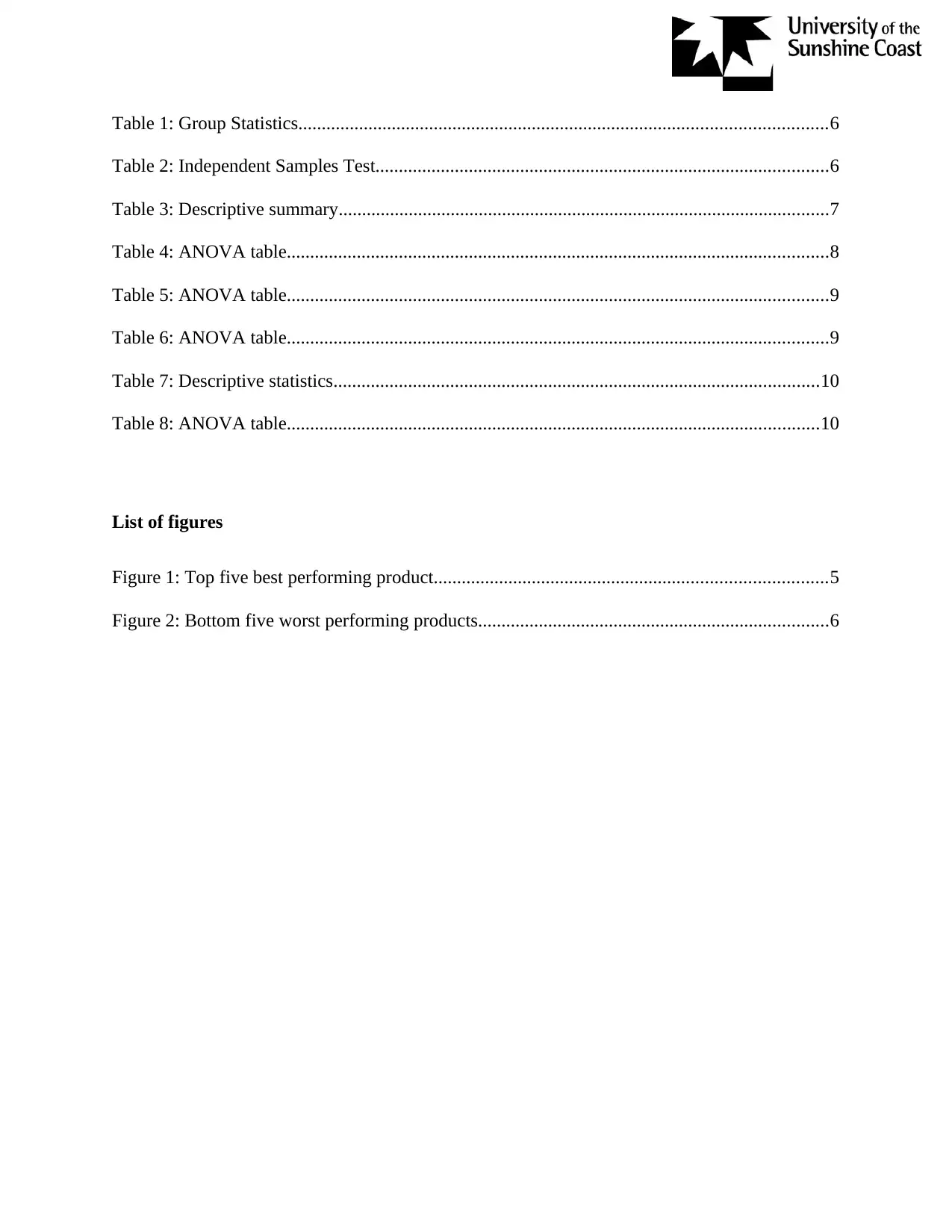
Table 1: Group Statistics.................................................................................................................6
Table 2: Independent Samples Test.................................................................................................6
Table 3: Descriptive summary.........................................................................................................7
Table 4: ANOVA table....................................................................................................................8
Table 5: ANOVA table....................................................................................................................9
Table 6: ANOVA table....................................................................................................................9
Table 7: Descriptive statistics........................................................................................................10
Table 8: ANOVA table..................................................................................................................10
List of figures
Figure 1: Top five best performing product....................................................................................5
Figure 2: Bottom five worst performing products...........................................................................6
Table 2: Independent Samples Test.................................................................................................6
Table 3: Descriptive summary.........................................................................................................7
Table 4: ANOVA table....................................................................................................................8
Table 5: ANOVA table....................................................................................................................9
Table 6: ANOVA table....................................................................................................................9
Table 7: Descriptive statistics........................................................................................................10
Table 8: ANOVA table..................................................................................................................10
List of figures
Figure 1: Top five best performing product....................................................................................5
Figure 2: Bottom five worst performing products...........................................................................6
⊘ This is a preview!⊘
Do you want full access?
Subscribe today to unlock all pages.

Trusted by 1+ million students worldwide
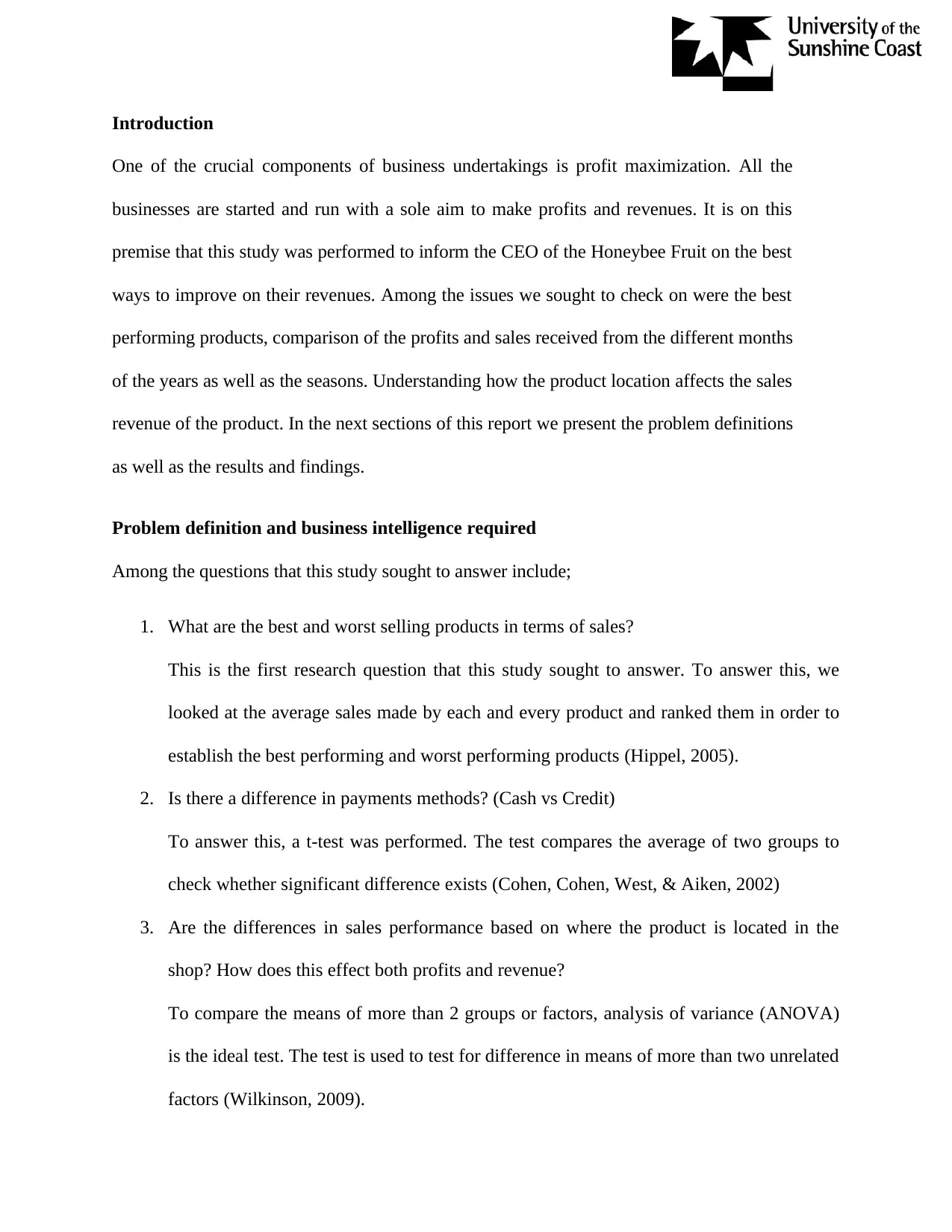
Introduction
One of the crucial components of business undertakings is profit maximization. All the
businesses are started and run with a sole aim to make profits and revenues. It is on this
premise that this study was performed to inform the CEO of the Honeybee Fruit on the best
ways to improve on their revenues. Among the issues we sought to check on were the best
performing products, comparison of the profits and sales received from the different months
of the years as well as the seasons. Understanding how the product location affects the sales
revenue of the product. In the next sections of this report we present the problem definitions
as well as the results and findings.
Problem definition and business intelligence required
Among the questions that this study sought to answer include;
1. What are the best and worst selling products in terms of sales?
This is the first research question that this study sought to answer. To answer this, we
looked at the average sales made by each and every product and ranked them in order to
establish the best performing and worst performing products (Hippel, 2005).
2. Is there a difference in payments methods? (Cash vs Credit)
To answer this, a t-test was performed. The test compares the average of two groups to
check whether significant difference exists (Cohen, Cohen, West, & Aiken, 2002)
3. Are the differences in sales performance based on where the product is located in the
shop? How does this effect both profits and revenue?
To compare the means of more than 2 groups or factors, analysis of variance (ANOVA)
is the ideal test. The test is used to test for difference in means of more than two unrelated
factors (Wilkinson, 2009).
One of the crucial components of business undertakings is profit maximization. All the
businesses are started and run with a sole aim to make profits and revenues. It is on this
premise that this study was performed to inform the CEO of the Honeybee Fruit on the best
ways to improve on their revenues. Among the issues we sought to check on were the best
performing products, comparison of the profits and sales received from the different months
of the years as well as the seasons. Understanding how the product location affects the sales
revenue of the product. In the next sections of this report we present the problem definitions
as well as the results and findings.
Problem definition and business intelligence required
Among the questions that this study sought to answer include;
1. What are the best and worst selling products in terms of sales?
This is the first research question that this study sought to answer. To answer this, we
looked at the average sales made by each and every product and ranked them in order to
establish the best performing and worst performing products (Hippel, 2005).
2. Is there a difference in payments methods? (Cash vs Credit)
To answer this, a t-test was performed. The test compares the average of two groups to
check whether significant difference exists (Cohen, Cohen, West, & Aiken, 2002)
3. Are the differences in sales performance based on where the product is located in the
shop? How does this effect both profits and revenue?
To compare the means of more than 2 groups or factors, analysis of variance (ANOVA)
is the ideal test. The test is used to test for difference in means of more than two unrelated
factors (Wilkinson, 2009).
Paraphrase This Document
Need a fresh take? Get an instant paraphrase of this document with our AI Paraphraser

4. Is there a difference in sales and gross profits between different months of the year?
This research question also requires comparison of more than 2 means and therefore
ANOVA test will be used.
5. Are their differences in sales performance between different seasons? (Summer, spring,
autumn, winter)
The same tests for questions 3 and 4 will apply in this section. This research question also
requires comparison of more than 2 means and therefore ANOVA test will be used.
Results of the selected analytics methods and technical analysis
What are the best and worst selling products in terms of sales?
The figure below gives the top five best performing products in terms of the sales. Water as can
be seen had the highest sales revenue (M = 1,867.08) followed by fruit (M = 1,048.67), vegetable
was third (M = 871.51) while dairy and drinks took fourth and fifth positions respectively.
Figure 1: Top five best performing product
This research question also requires comparison of more than 2 means and therefore
ANOVA test will be used.
5. Are their differences in sales performance between different seasons? (Summer, spring,
autumn, winter)
The same tests for questions 3 and 4 will apply in this section. This research question also
requires comparison of more than 2 means and therefore ANOVA test will be used.
Results of the selected analytics methods and technical analysis
What are the best and worst selling products in terms of sales?
The figure below gives the top five best performing products in terms of the sales. Water as can
be seen had the highest sales revenue (M = 1,867.08) followed by fruit (M = 1,048.67), vegetable
was third (M = 871.51) while dairy and drinks took fourth and fifth positions respectively.
Figure 1: Top five best performing product
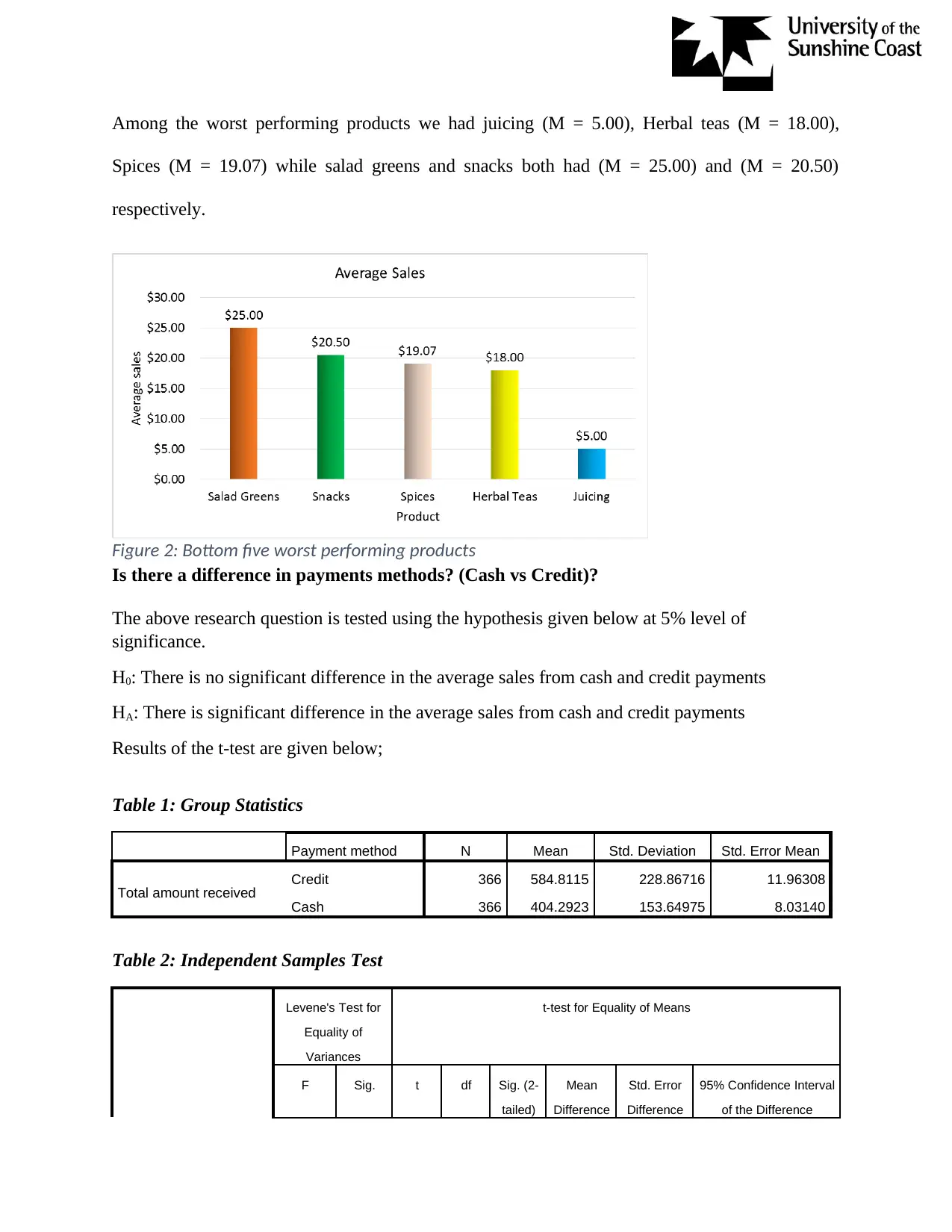
Among the worst performing products we had juicing (M = 5.00), Herbal teas (M = 18.00),
Spices (M = 19.07) while salad greens and snacks both had (M = 25.00) and (M = 20.50)
respectively.
Figure 2: Bottom five worst performing products
Is there a difference in payments methods? (Cash vs Credit)?
The above research question is tested using the hypothesis given below at 5% level of
significance.
H0: There is no significant difference in the average sales from cash and credit payments
HA: There is significant difference in the average sales from cash and credit payments
Results of the t-test are given below;
Table 1: Group Statistics
Payment method N Mean Std. Deviation Std. Error Mean
Total amount received Credit 366 584.8115 228.86716 11.96308
Cash 366 404.2923 153.64975 8.03140
Table 2: Independent Samples Test
Levene's Test for
Equality of
Variances
t-test for Equality of Means
F Sig. t df Sig. (2-
tailed)
Mean
Difference
Std. Error
Difference
95% Confidence Interval
of the Difference
Spices (M = 19.07) while salad greens and snacks both had (M = 25.00) and (M = 20.50)
respectively.
Figure 2: Bottom five worst performing products
Is there a difference in payments methods? (Cash vs Credit)?
The above research question is tested using the hypothesis given below at 5% level of
significance.
H0: There is no significant difference in the average sales from cash and credit payments
HA: There is significant difference in the average sales from cash and credit payments
Results of the t-test are given below;
Table 1: Group Statistics
Payment method N Mean Std. Deviation Std. Error Mean
Total amount received Credit 366 584.8115 228.86716 11.96308
Cash 366 404.2923 153.64975 8.03140
Table 2: Independent Samples Test
Levene's Test for
Equality of
Variances
t-test for Equality of Means
F Sig. t df Sig. (2-
tailed)
Mean
Difference
Std. Error
Difference
95% Confidence Interval
of the Difference
⊘ This is a preview!⊘
Do you want full access?
Subscribe today to unlock all pages.

Trusted by 1+ million students worldwide
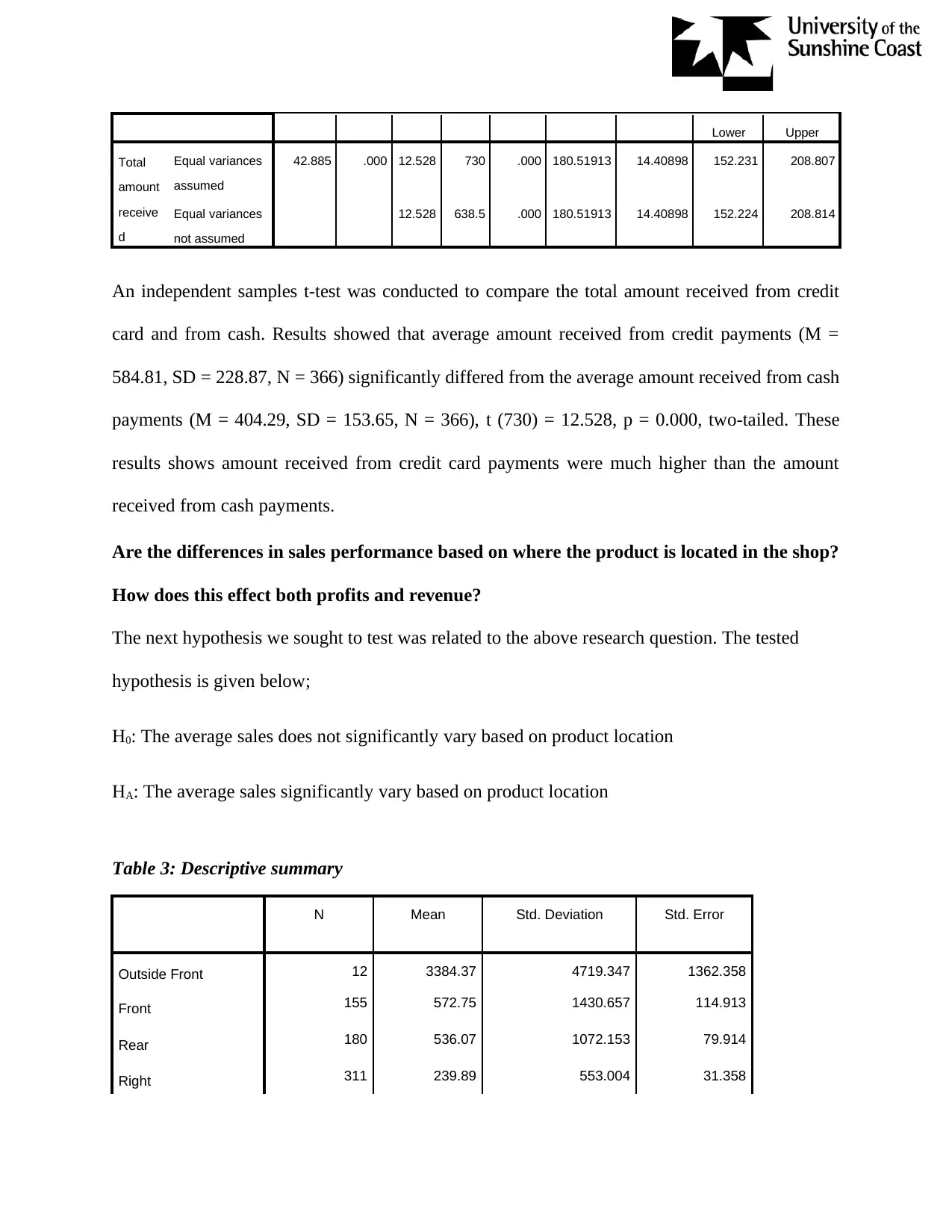
Lower Upper
Total
amount
receive
d
Equal variances
assumed
42.885 .000 12.528 730 .000 180.51913 14.40898 152.231 208.807
Equal variances
not assumed
12.528 638.5 .000 180.51913 14.40898 152.224 208.814
An independent samples t-test was conducted to compare the total amount received from credit
card and from cash. Results showed that average amount received from credit payments (M =
584.81, SD = 228.87, N = 366) significantly differed from the average amount received from cash
payments (M = 404.29, SD = 153.65, N = 366), t (730) = 12.528, p = 0.000, two-tailed. These
results shows amount received from credit card payments were much higher than the amount
received from cash payments.
Are the differences in sales performance based on where the product is located in the shop?
How does this effect both profits and revenue?
The next hypothesis we sought to test was related to the above research question. The tested
hypothesis is given below;
H0: The average sales does not significantly vary based on product location
HA: The average sales significantly vary based on product location
Table 3: Descriptive summary
N Mean Std. Deviation Std. Error
Outside Front 12 3384.37 4719.347 1362.358
Front 155 572.75 1430.657 114.913
Rear 180 536.07 1072.153 79.914
Right 311 239.89 553.004 31.358
Total
amount
receive
d
Equal variances
assumed
42.885 .000 12.528 730 .000 180.51913 14.40898 152.231 208.807
Equal variances
not assumed
12.528 638.5 .000 180.51913 14.40898 152.224 208.814
An independent samples t-test was conducted to compare the total amount received from credit
card and from cash. Results showed that average amount received from credit payments (M =
584.81, SD = 228.87, N = 366) significantly differed from the average amount received from cash
payments (M = 404.29, SD = 153.65, N = 366), t (730) = 12.528, p = 0.000, two-tailed. These
results shows amount received from credit card payments were much higher than the amount
received from cash payments.
Are the differences in sales performance based on where the product is located in the shop?
How does this effect both profits and revenue?
The next hypothesis we sought to test was related to the above research question. The tested
hypothesis is given below;
H0: The average sales does not significantly vary based on product location
HA: The average sales significantly vary based on product location
Table 3: Descriptive summary
N Mean Std. Deviation Std. Error
Outside Front 12 3384.37 4719.347 1362.358
Front 155 572.75 1430.657 114.913
Rear 180 536.07 1072.153 79.914
Right 311 239.89 553.004 31.358
Paraphrase This Document
Need a fresh take? Get an instant paraphrase of this document with our AI Paraphraser
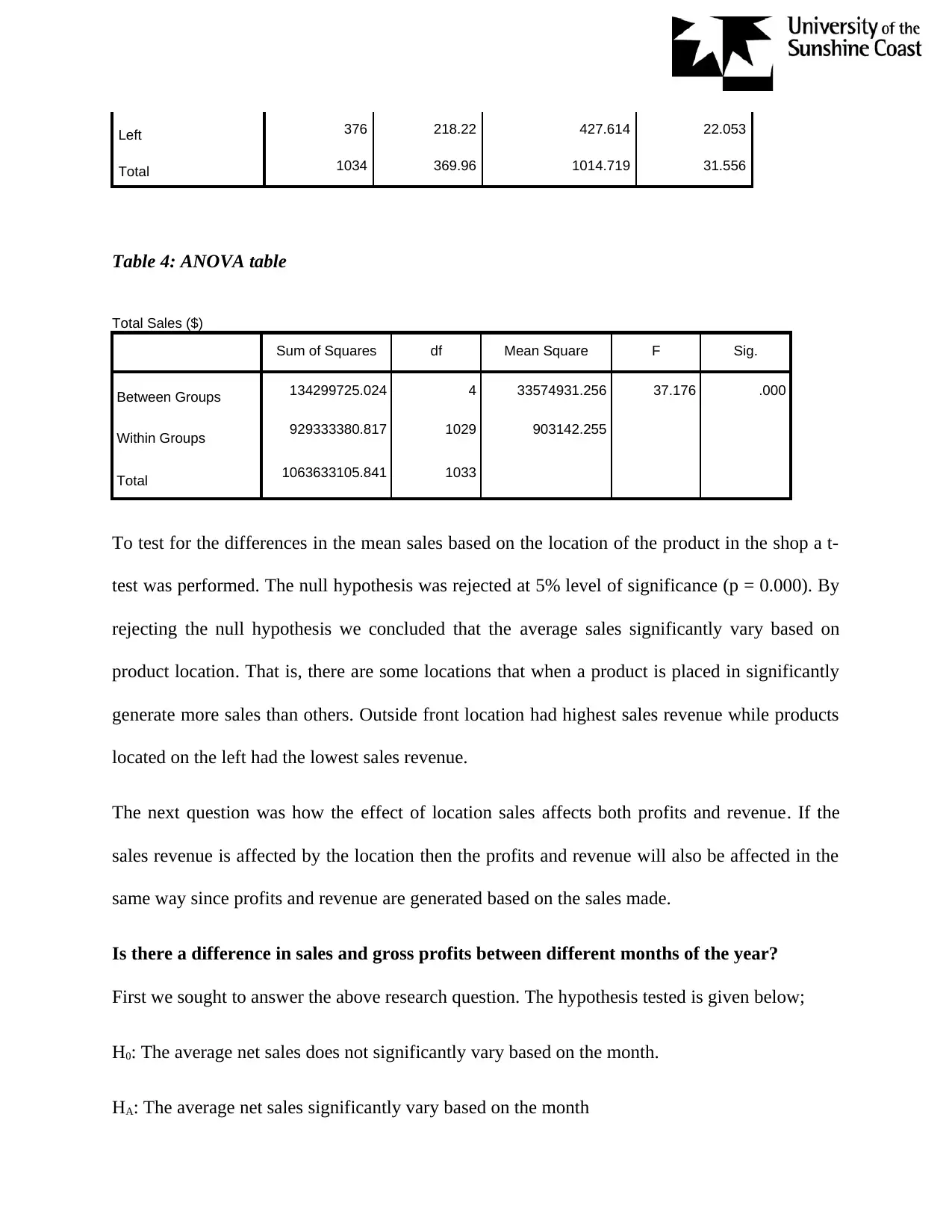
Left 376 218.22 427.614 22.053
Total 1034 369.96 1014.719 31.556
Table 4: ANOVA table
Total Sales ($)
Sum of Squares df Mean Square F Sig.
Between Groups 134299725.024 4 33574931.256 37.176 .000
Within Groups 929333380.817 1029 903142.255
Total 1063633105.841 1033
To test for the differences in the mean sales based on the location of the product in the shop a t-
test was performed. The null hypothesis was rejected at 5% level of significance (p = 0.000). By
rejecting the null hypothesis we concluded that the average sales significantly vary based on
product location. That is, there are some locations that when a product is placed in significantly
generate more sales than others. Outside front location had highest sales revenue while products
located on the left had the lowest sales revenue.
The next question was how the effect of location sales affects both profits and revenue. If the
sales revenue is affected by the location then the profits and revenue will also be affected in the
same way since profits and revenue are generated based on the sales made.
Is there a difference in sales and gross profits between different months of the year?
First we sought to answer the above research question. The hypothesis tested is given below;
H0: The average net sales does not significantly vary based on the month.
HA: The average net sales significantly vary based on the month
Total 1034 369.96 1014.719 31.556
Table 4: ANOVA table
Total Sales ($)
Sum of Squares df Mean Square F Sig.
Between Groups 134299725.024 4 33574931.256 37.176 .000
Within Groups 929333380.817 1029 903142.255
Total 1063633105.841 1033
To test for the differences in the mean sales based on the location of the product in the shop a t-
test was performed. The null hypothesis was rejected at 5% level of significance (p = 0.000). By
rejecting the null hypothesis we concluded that the average sales significantly vary based on
product location. That is, there are some locations that when a product is placed in significantly
generate more sales than others. Outside front location had highest sales revenue while products
located on the left had the lowest sales revenue.
The next question was how the effect of location sales affects both profits and revenue. If the
sales revenue is affected by the location then the profits and revenue will also be affected in the
same way since profits and revenue are generated based on the sales made.
Is there a difference in sales and gross profits between different months of the year?
First we sought to answer the above research question. The hypothesis tested is given below;
H0: The average net sales does not significantly vary based on the month.
HA: The average net sales significantly vary based on the month
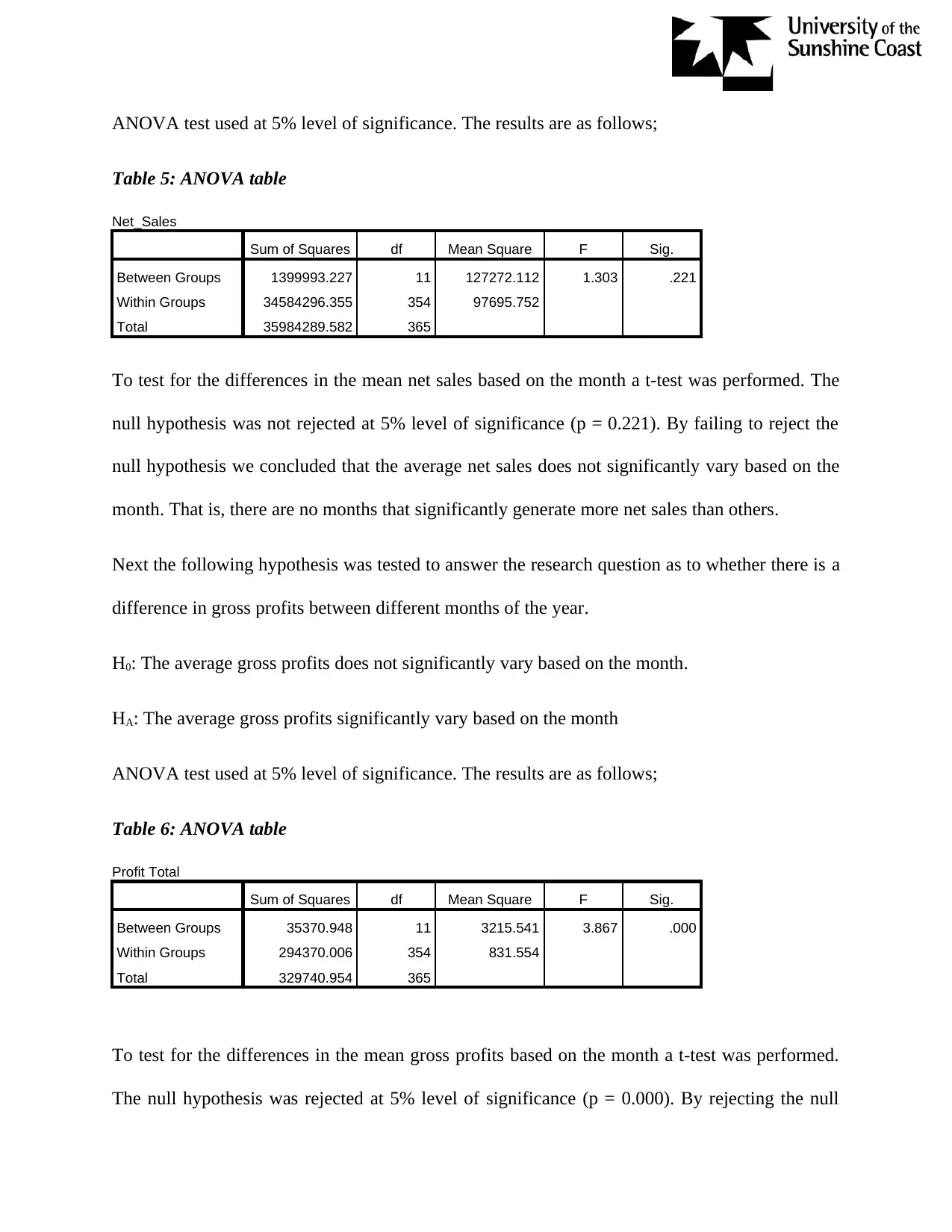
ANOVA test used at 5% level of significance. The results are as follows;
Table 5: ANOVA table
Net_Sales
Sum of Squares df Mean Square F Sig.
Between Groups 1399993.227 11 127272.112 1.303 .221
Within Groups 34584296.355 354 97695.752
Total 35984289.582 365
To test for the differences in the mean net sales based on the month a t-test was performed. The
null hypothesis was not rejected at 5% level of significance (p = 0.221). By failing to reject the
null hypothesis we concluded that the average net sales does not significantly vary based on the
month. That is, there are no months that significantly generate more net sales than others.
Next the following hypothesis was tested to answer the research question as to whether there is a
difference in gross profits between different months of the year.
H0: The average gross profits does not significantly vary based on the month.
HA: The average gross profits significantly vary based on the month
ANOVA test used at 5% level of significance. The results are as follows;
Table 6: ANOVA table
Profit Total
Sum of Squares df Mean Square F Sig.
Between Groups 35370.948 11 3215.541 3.867 .000
Within Groups 294370.006 354 831.554
Total 329740.954 365
To test for the differences in the mean gross profits based on the month a t-test was performed.
The null hypothesis was rejected at 5% level of significance (p = 0.000). By rejecting the null
Table 5: ANOVA table
Net_Sales
Sum of Squares df Mean Square F Sig.
Between Groups 1399993.227 11 127272.112 1.303 .221
Within Groups 34584296.355 354 97695.752
Total 35984289.582 365
To test for the differences in the mean net sales based on the month a t-test was performed. The
null hypothesis was not rejected at 5% level of significance (p = 0.221). By failing to reject the
null hypothesis we concluded that the average net sales does not significantly vary based on the
month. That is, there are no months that significantly generate more net sales than others.
Next the following hypothesis was tested to answer the research question as to whether there is a
difference in gross profits between different months of the year.
H0: The average gross profits does not significantly vary based on the month.
HA: The average gross profits significantly vary based on the month
ANOVA test used at 5% level of significance. The results are as follows;
Table 6: ANOVA table
Profit Total
Sum of Squares df Mean Square F Sig.
Between Groups 35370.948 11 3215.541 3.867 .000
Within Groups 294370.006 354 831.554
Total 329740.954 365
To test for the differences in the mean gross profits based on the month a t-test was performed.
The null hypothesis was rejected at 5% level of significance (p = 0.000). By rejecting the null
⊘ This is a preview!⊘
Do you want full access?
Subscribe today to unlock all pages.

Trusted by 1+ million students worldwide
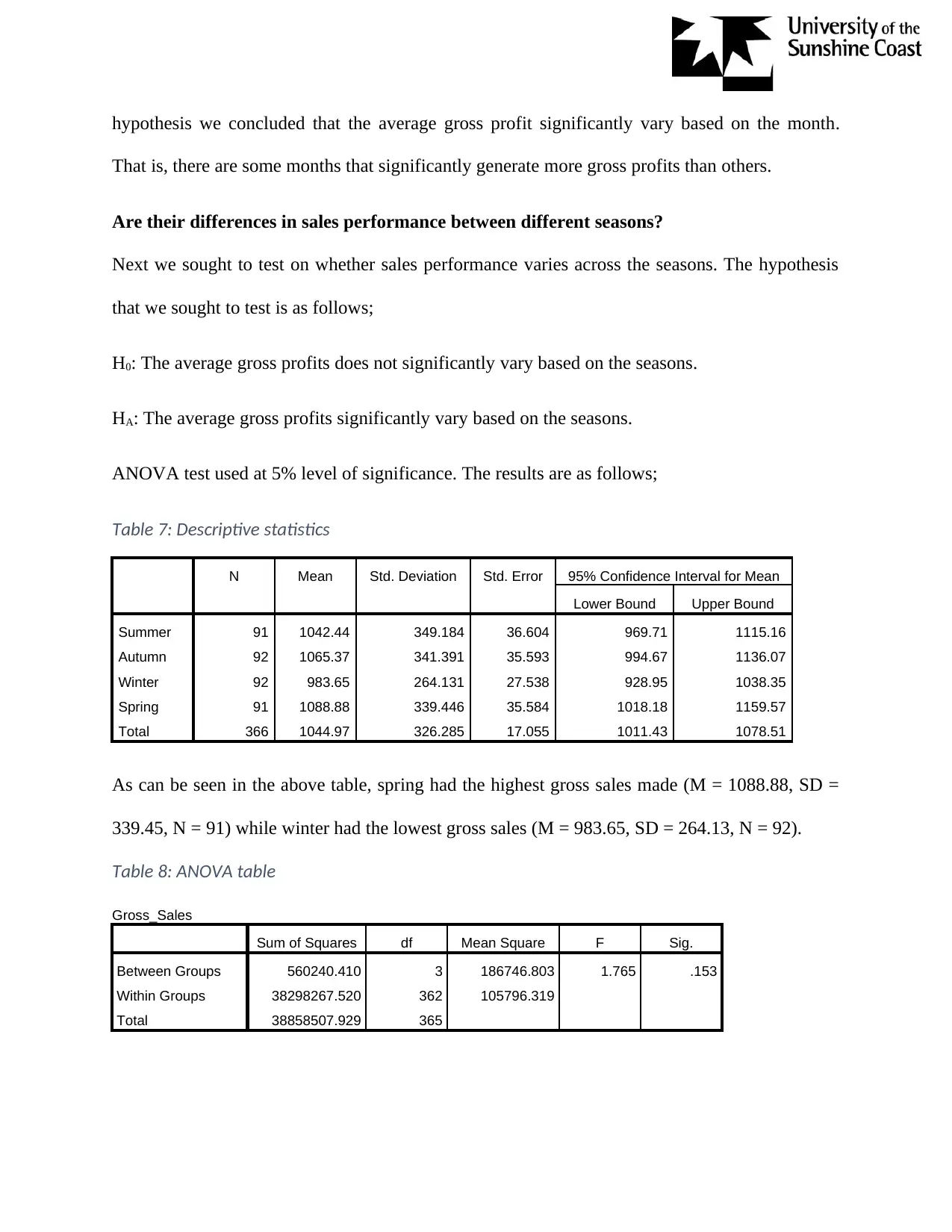
hypothesis we concluded that the average gross profit significantly vary based on the month.
That is, there are some months that significantly generate more gross profits than others.
Are their differences in sales performance between different seasons?
Next we sought to test on whether sales performance varies across the seasons. The hypothesis
that we sought to test is as follows;
H0: The average gross profits does not significantly vary based on the seasons.
HA: The average gross profits significantly vary based on the seasons.
ANOVA test used at 5% level of significance. The results are as follows;
Table 7: Descriptive statistics
N Mean Std. Deviation Std. Error 95% Confidence Interval for Mean
Lower Bound Upper Bound
Summer 91 1042.44 349.184 36.604 969.71 1115.16
Autumn 92 1065.37 341.391 35.593 994.67 1136.07
Winter 92 983.65 264.131 27.538 928.95 1038.35
Spring 91 1088.88 339.446 35.584 1018.18 1159.57
Total 366 1044.97 326.285 17.055 1011.43 1078.51
As can be seen in the above table, spring had the highest gross sales made (M = 1088.88, SD =
339.45, N = 91) while winter had the lowest gross sales (M = 983.65, SD = 264.13, N = 92).
Table 8: ANOVA table
Gross_Sales
Sum of Squares df Mean Square F Sig.
Between Groups 560240.410 3 186746.803 1.765 .153
Within Groups 38298267.520 362 105796.319
Total 38858507.929 365
That is, there are some months that significantly generate more gross profits than others.
Are their differences in sales performance between different seasons?
Next we sought to test on whether sales performance varies across the seasons. The hypothesis
that we sought to test is as follows;
H0: The average gross profits does not significantly vary based on the seasons.
HA: The average gross profits significantly vary based on the seasons.
ANOVA test used at 5% level of significance. The results are as follows;
Table 7: Descriptive statistics
N Mean Std. Deviation Std. Error 95% Confidence Interval for Mean
Lower Bound Upper Bound
Summer 91 1042.44 349.184 36.604 969.71 1115.16
Autumn 92 1065.37 341.391 35.593 994.67 1136.07
Winter 92 983.65 264.131 27.538 928.95 1038.35
Spring 91 1088.88 339.446 35.584 1018.18 1159.57
Total 366 1044.97 326.285 17.055 1011.43 1078.51
As can be seen in the above table, spring had the highest gross sales made (M = 1088.88, SD =
339.45, N = 91) while winter had the lowest gross sales (M = 983.65, SD = 264.13, N = 92).
Table 8: ANOVA table
Gross_Sales
Sum of Squares df Mean Square F Sig.
Between Groups 560240.410 3 186746.803 1.765 .153
Within Groups 38298267.520 362 105796.319
Total 38858507.929 365
Paraphrase This Document
Need a fresh take? Get an instant paraphrase of this document with our AI Paraphraser
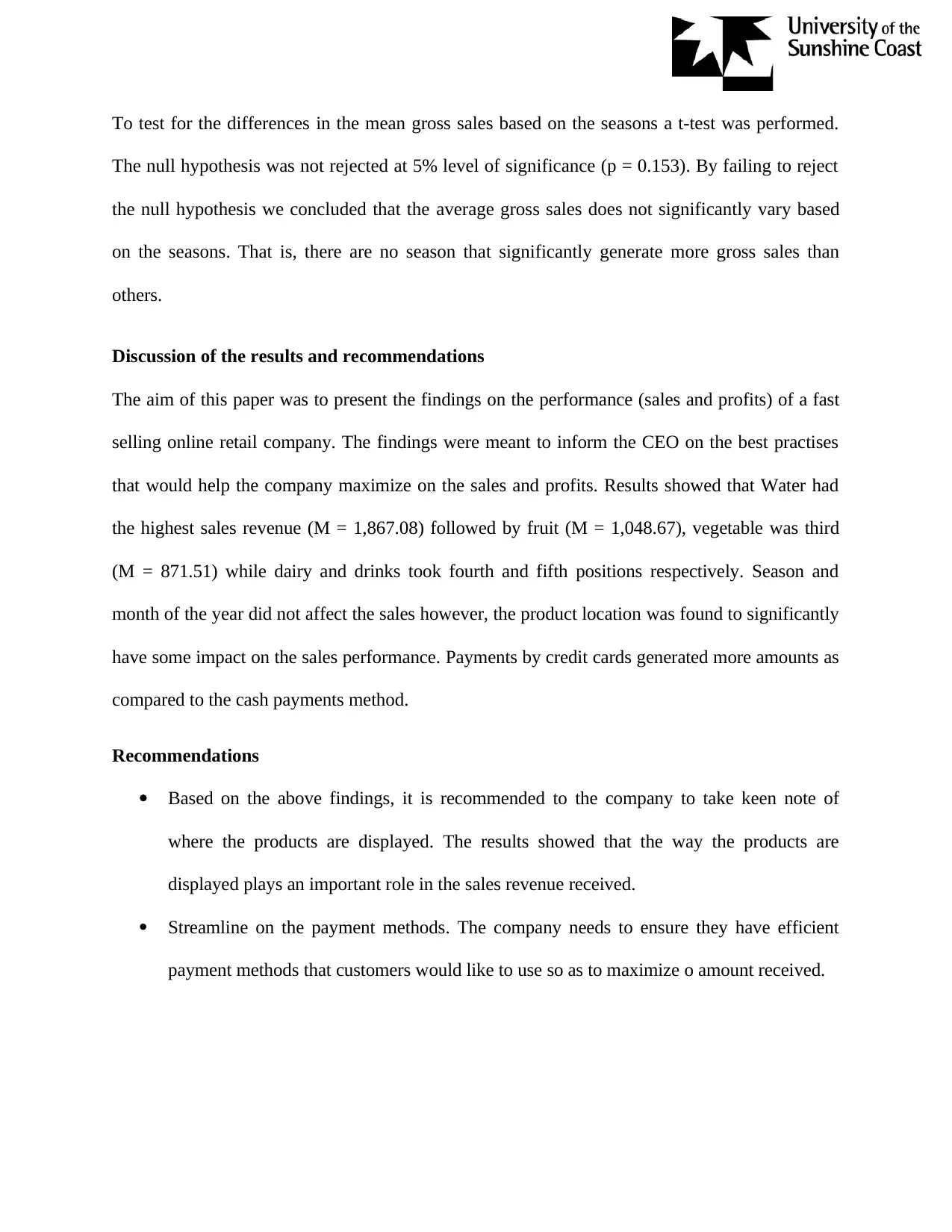
To test for the differences in the mean gross sales based on the seasons a t-test was performed.
The null hypothesis was not rejected at 5% level of significance (p = 0.153). By failing to reject
the null hypothesis we concluded that the average gross sales does not significantly vary based
on the seasons. That is, there are no season that significantly generate more gross sales than
others.
Discussion of the results and recommendations
The aim of this paper was to present the findings on the performance (sales and profits) of a fast
selling online retail company. The findings were meant to inform the CEO on the best practises
that would help the company maximize on the sales and profits. Results showed that Water had
the highest sales revenue (M = 1,867.08) followed by fruit (M = 1,048.67), vegetable was third
(M = 871.51) while dairy and drinks took fourth and fifth positions respectively. Season and
month of the year did not affect the sales however, the product location was found to significantly
have some impact on the sales performance. Payments by credit cards generated more amounts as
compared to the cash payments method.
Recommendations
Based on the above findings, it is recommended to the company to take keen note of
where the products are displayed. The results showed that the way the products are
displayed plays an important role in the sales revenue received.
Streamline on the payment methods. The company needs to ensure they have efficient
payment methods that customers would like to use so as to maximize o amount received.
The null hypothesis was not rejected at 5% level of significance (p = 0.153). By failing to reject
the null hypothesis we concluded that the average gross sales does not significantly vary based
on the seasons. That is, there are no season that significantly generate more gross sales than
others.
Discussion of the results and recommendations
The aim of this paper was to present the findings on the performance (sales and profits) of a fast
selling online retail company. The findings were meant to inform the CEO on the best practises
that would help the company maximize on the sales and profits. Results showed that Water had
the highest sales revenue (M = 1,867.08) followed by fruit (M = 1,048.67), vegetable was third
(M = 871.51) while dairy and drinks took fourth and fifth positions respectively. Season and
month of the year did not affect the sales however, the product location was found to significantly
have some impact on the sales performance. Payments by credit cards generated more amounts as
compared to the cash payments method.
Recommendations
Based on the above findings, it is recommended to the company to take keen note of
where the products are displayed. The results showed that the way the products are
displayed plays an important role in the sales revenue received.
Streamline on the payment methods. The company needs to ensure they have efficient
payment methods that customers would like to use so as to maximize o amount received.
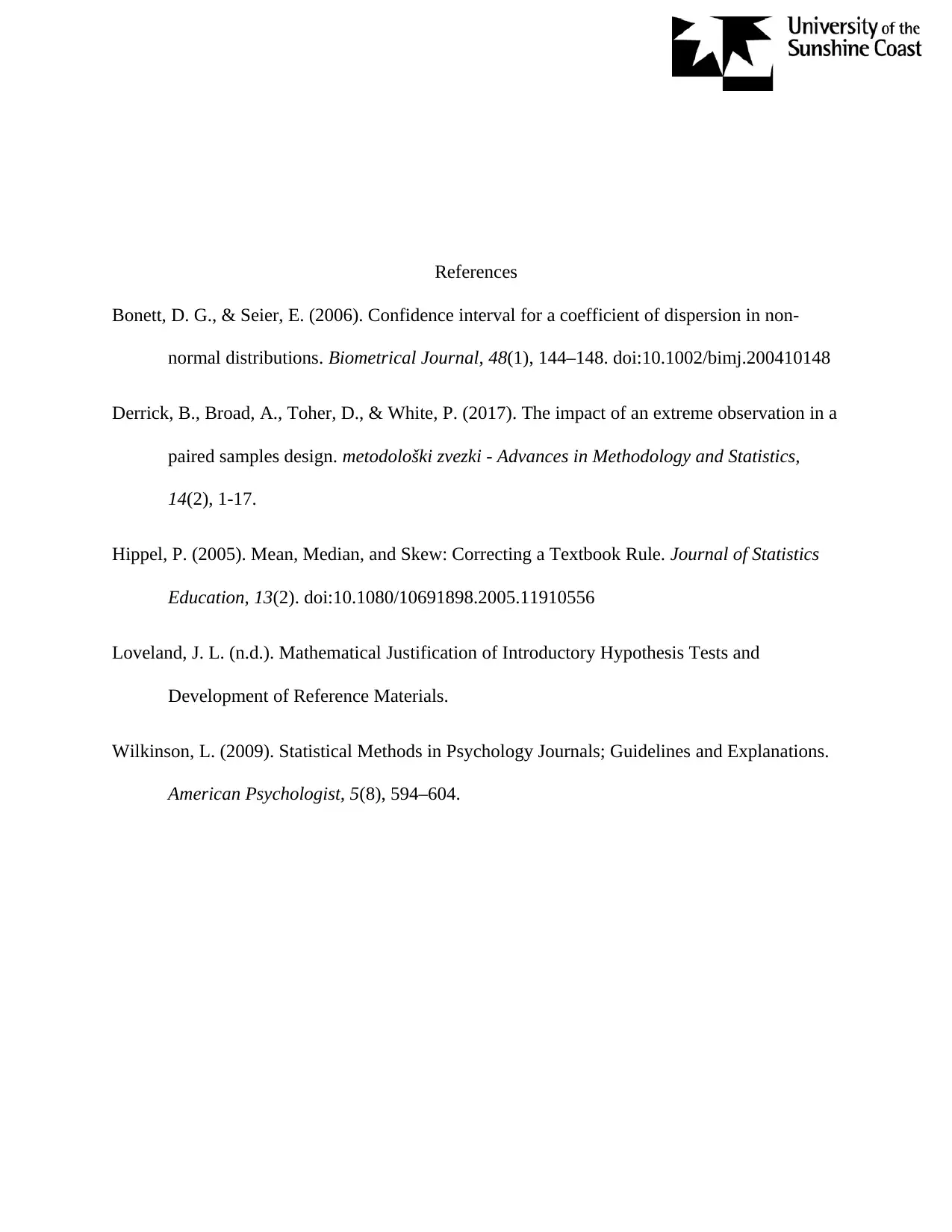
References
Bonett, D. G., & Seier, E. (2006). Confidence interval for a coefficient of dispersion in non-
normal distributions. Biometrical Journal, 48(1), 144–148. doi:10.1002/bimj.200410148
Derrick, B., Broad, A., Toher, D., & White, P. (2017). The impact of an extreme observation in a
paired samples design. metodološki zvezki - Advances in Methodology and Statistics,
14(2), 1-17.
Hippel, P. (2005). Mean, Median, and Skew: Correcting a Textbook Rule. Journal of Statistics
Education, 13(2). doi:10.1080/10691898.2005.11910556
Loveland, J. L. (n.d.). Mathematical Justification of Introductory Hypothesis Tests and
Development of Reference Materials.
Wilkinson, L. (2009). Statistical Methods in Psychology Journals; Guidelines and Explanations.
American Psychologist, 5(8), 594–604.
Bonett, D. G., & Seier, E. (2006). Confidence interval for a coefficient of dispersion in non-
normal distributions. Biometrical Journal, 48(1), 144–148. doi:10.1002/bimj.200410148
Derrick, B., Broad, A., Toher, D., & White, P. (2017). The impact of an extreme observation in a
paired samples design. metodološki zvezki - Advances in Methodology and Statistics,
14(2), 1-17.
Hippel, P. (2005). Mean, Median, and Skew: Correcting a Textbook Rule. Journal of Statistics
Education, 13(2). doi:10.1080/10691898.2005.11910556
Loveland, J. L. (n.d.). Mathematical Justification of Introductory Hypothesis Tests and
Development of Reference Materials.
Wilkinson, L. (2009). Statistical Methods in Psychology Journals; Guidelines and Explanations.
American Psychologist, 5(8), 594–604.
⊘ This is a preview!⊘
Do you want full access?
Subscribe today to unlock all pages.

Trusted by 1+ million students worldwide
1 out of 16
Related Documents
Your All-in-One AI-Powered Toolkit for Academic Success.
+13062052269
info@desklib.com
Available 24*7 on WhatsApp / Email
![[object Object]](/_next/static/media/star-bottom.7253800d.svg)
Unlock your academic potential
Copyright © 2020–2025 A2Z Services. All Rights Reserved. Developed and managed by ZUCOL.




